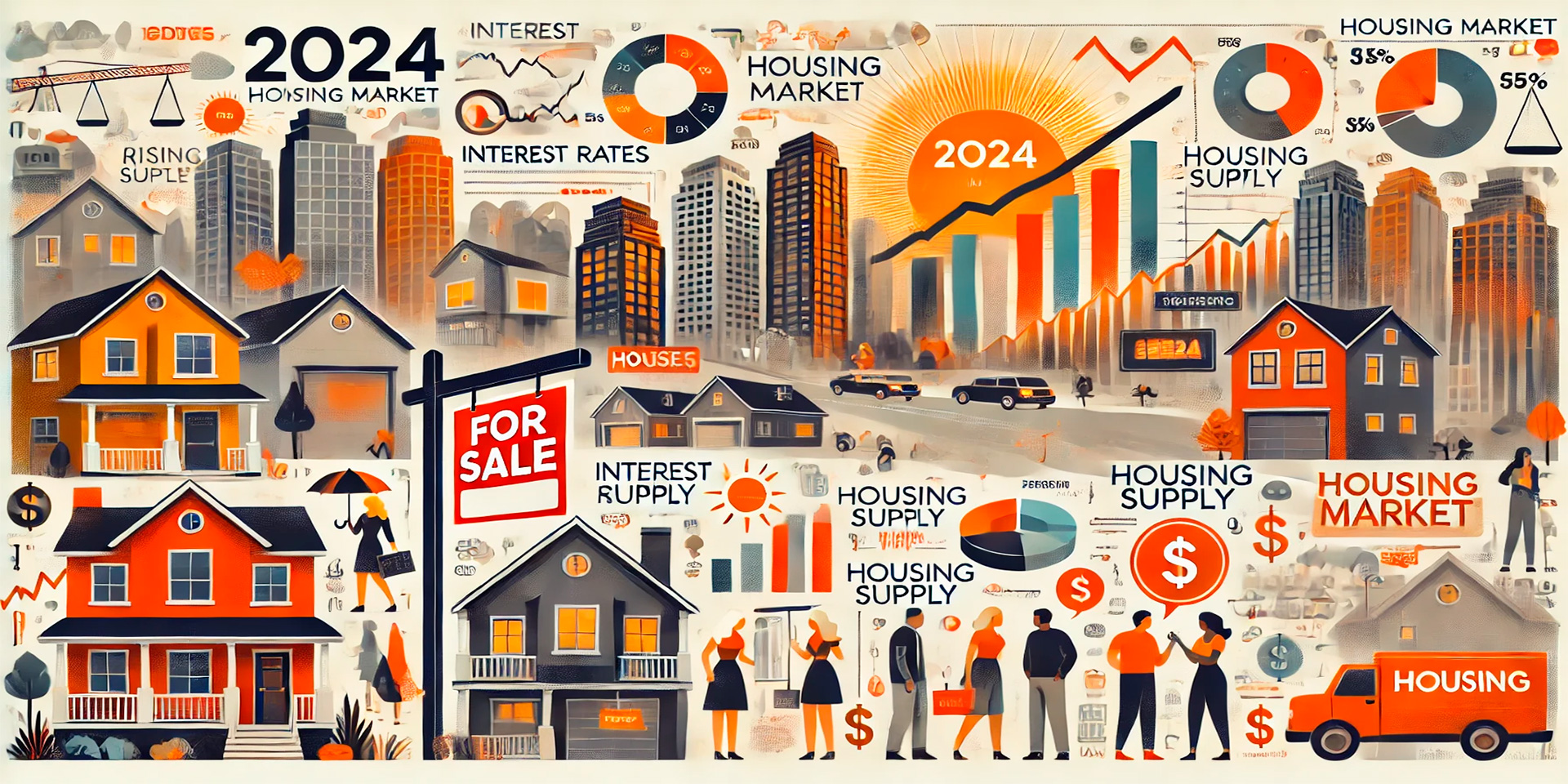The housing market in 2024 is poised for significant changes as economic conditions, interest rates, and shifting demographics reshape the landscape for both buyers and renters. Whether you’re planning to purchase a home or are looking for a rental, understanding the emerging trends in the housing market will help you make informed decisions. With a combination of rising interest rates, evolving buyer preferences, and fluctuating rental demand, 2024 is expected to bring both opportunities and challenges for consumers.
The Role of Interest Rates in the 2024 Housing Market
One of the most critical factors shaping the housing market in 2024 is the direction of interest rates. As the Federal Reserve continues to manage inflation, interest rates are expected to remain elevated, making borrowing more expensive for homebuyers. Higher mortgage rates can significantly affect affordability, as monthly payments increase with even a small rise in interest rates. This trend is likely to push some potential buyers to the sidelines, reducing demand for homes, especially in markets where prices are already high.
For buyers who can afford higher rates, there may be opportunities to negotiate better deals as sellers adjust to softer demand. On the flip side, higher borrowing costs may also discourage some sellers from listing their homes, especially if they have locked in lower mortgage rates, further limiting inventory in an already tight housing market.
Renters will also feel the effects of rising interest rates. As buying becomes more expensive, rental demand may increase as more people choose to rent rather than purchase. This could put upward pressure on rental prices, especially in cities where housing shortages are already an issue.
Slower Home Price Growth
After several years of rapid home price appreciation, the pace of price growth is expected to slow in 2024. While home prices are unlikely to decline significantly on a national level, certain overheated markets could experience price corrections as demand wanes due to higher interest rates and affordability challenges.
For buyers, this means there may be more opportunities to purchase homes without facing the intense bidding wars that characterized previous years. However, in markets where supply remains constrained, prices are still expected to rise, albeit at a slower pace. Buyers should be prepared for a more balanced market, where negotiations between buyers and sellers are more common, and the market becomes less competitive.
Renters, on the other hand, may not see the same relief. In high-demand rental markets, prices could continue to rise as fewer people move into homeownership due to affordability concerns. In some cities, rental prices may increase faster than home prices, making it crucial for renters to secure leases in desirable locations before further price hikes occur.
Regional Differences in Price Trends
Regional variations will play a significant role in determining home price trends in 2024. Coastal cities and tech hubs, which experienced significant price surges during the pandemic, may see a cooling-off period, while more affordable regions in the Midwest and Southeast could continue to attract buyers seeking value. Buyers should be aware that while prices may stabilize in some regions, others could remain hot due to population growth and economic opportunities.

Inventory Challenges and New Construction
One of the ongoing challenges in the housing market has been a lack of inventory, particularly in affordable housing. In 2024, this trend is expected to persist, as builders struggle to keep up with demand due to rising material costs, labor shortages, and supply chain disruptions. While some new construction is expected to come online, it may not be enough to meet demand in many markets, especially for entry-level homes.
For buyers, this means that the supply of homes available for sale will likely remain limited, particularly in fast-growing areas. As a result, buyers may need to adjust their expectations, be open to fixer-uppers, or consider expanding their search to less competitive markets.
Renters may also feel the effects of the inventory shortage, particularly in urban areas where new apartment construction has not kept pace with population growth. While some cities may see new developments aimed at high-end renters, affordable rental units may remain scarce, contributing to rising rents in certain markets.
The Shift Toward Smaller, More Efficient Homes
As housing affordability becomes a growing concern, there is a trend toward building smaller, more efficient homes. These homes, designed with energy efficiency and functionality in mind, cater to buyers looking for affordable options without sacrificing modern amenities. In 2024, expect to see more new construction focusing on smaller homes, townhouses, and condos that appeal to first-time buyers and those looking to downsize.
For buyers, this trend offers more affordable entry points into homeownership, especially in markets where larger homes remain out of reach. Renters, too, may benefit from smaller, more affordable apartment options, particularly in high-density urban areas.
Remote Work and Its Impact on Housing Preferences
The remote work revolution that accelerated during the pandemic is expected to continue influencing housing trends in 2024. As more companies adopt flexible work policies, employees are increasingly seeking homes in suburban or rural areas, where they can enjoy more space and lower costs of living while still maintaining access to urban amenities.
For buyers, this trend means more opportunities to explore housing markets outside traditional city centers. Suburbs and exurbs are likely to remain popular, particularly in regions where home prices are still relatively affordable. Buyers looking for more space, larger homes, or proximity to nature may find 2024 to be an ideal time to make a move, especially if remote work continues to offer flexibility.
For renters, the impact of remote work may result in increased demand for rental properties in suburban areas. While urban apartments remain popular among younger renters, those with families or remote work arrangements may prioritize rentals that offer more space and outdoor areas.

Increased Focus on Sustainable and Energy-Efficient Homes
Sustainability is becoming a more important factor in homebuying decisions, and this trend is expected to gain momentum in 2024. With rising energy costs and growing awareness of climate change, both buyers and renters are prioritizing energy-efficient homes that reduce utility bills and have a smaller environmental footprint. Green building practices, solar panels, energy-efficient appliances, and sustainable materials are likely to become more common in new construction and home renovations.
For buyers, homes with sustainable features may offer long-term savings and increase in value over time, as demand for eco-friendly properties grows. Homebuyers should look for energy-efficient upgrades and certifications that demonstrate a commitment to sustainability, which can also make a home more appealing in the resale market.
Renters are also becoming more conscious of energy efficiency, with many seeking out apartments and homes with lower utility costs. Landlords who invest in energy-efficient upgrades may be able to attract tenants willing to pay a premium for the long-term savings and environmental benefits these features provide.
What Renters Should Expect in 2024
The rental market in 2024 is likely to be shaped by several factors, including rising interest rates, increased demand for affordable rentals, and shifts in housing preferences due to remote work. As more potential buyers are priced out of the housing market, demand for rental properties may rise, leading to higher rents in certain markets. Additionally, new rental developments may focus on high-end, luxury units, leaving a shortage of affordable housing options for lower- and middle-income renters.
Renters should prepare for continued competition, particularly in popular urban and suburban areas. In high-demand markets, landlords may have the upper hand, with fewer concessions or rental discounts than in previous years. However, renters who are flexible about location may find better deals in less competitive markets or in newer developments aimed at attracting remote workers.
Long-Term Leases and Rent Control
As rental prices rise, more renters may opt for longer-term leases to lock in current rates and avoid potential increases. Additionally, rent control policies may gain traction in certain cities, as local governments respond to affordability concerns. Renters in areas with rent control laws should stay informed about their rights and protections, while those in less regulated markets may need to negotiate lease terms carefully to avoid steep increases during renewal periods.
Conclusion: Preparing for the Housing Market in 2024
The housing market in 2024 is expected to bring both challenges and opportunities for buyers and renters. With higher interest rates, slower price growth, and ongoing inventory shortages, buyers will need to navigate a more balanced but still competitive market. Meanwhile, renters may face rising rents and increased demand for affordable housing as the cost of homeownership rises.
Understanding these trends will help consumers make informed decisions about when and where to buy or rent, allowing them to take advantage of opportunities while managing potential risks. Whether you’re looking to purchase a home or secure a rental, staying informed about the latest housing market trends will be crucial to achieving your housing goals in 2024.

